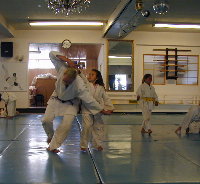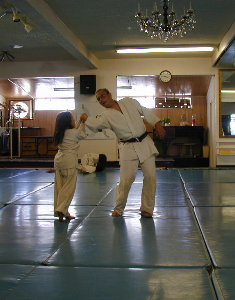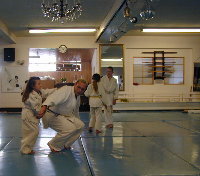

John Sing (singj@us.ibm.com)
August 30, 2001
This article is Chapter 2 in a three part series about Ken Ota Sensei's unique, successful, and innovative approach to teaching Aikido to children. It is based on over 35 successful years of excellence in teaching Aikido, Judo, and Ballroom Dancing to both adults and children, using a complete physical / emotional / psychological approach.
In this article, we'll examine in depth Ota Sensei's successful methods and suggestions for increasing your fun and effectiveness in teaching Aikido to Children, focusing on the topics of Dynamic Ma'ai and Backleading.
This 3 part series discussed:
Kenji Ota Sensei
Goleta Aikido with Ki
255 Magnolia
Goleta, California 93117
(805) 967-3103
http://www.west.net/~aikido/
Q: Ota Sensei, what is the major adjustment that we need to make
to Aikido techniques for children to be effective, and for them to
learn
Aikido most quickly?
Ota Sensei: After advanced ukemi, the next major essential element is to teach children proper ma'ai.

Aikido children need strong hopping, skipping, and movement skills so they can maintain ma'ai against much larger and stronger ukes. We have specific drills to teach hopping and turning, in order that the children learn distance and ma'ai. As their hopping skills grown, they are able to maintain ma'ai naturally, easily at all time, even at very dynamic, high speeds. The children then attain full effectiveness at realistic levels against adult ukes. As you can imagine, this is a tremendous confidence boost and source of satisfaction.
Ma'ai removes the need for Aikido Children to have to fuss much with the technical aspects of Aikido locks until they are much older and bigger. Small children especially benefit from our suggested emphasis on Aikido dynamic movement with the whole body:
Q: Is it possible for young children to truly be effective against larger adult sized ukes?

Ota Sensei: Absolutely! We know it is fully possible for Kid's Aikido is to be effective in reality against large real life adult's size and weight because our children are able to do it. The key is that the children have full ability to move large distances quickly with spontaneous, powerful Aikido movement. It is this ability to keep smoothly keep ma'ai at high speed against large adult ukes that generates off balance and allows children to actually perform effective powerful technique.
The added advantage of good ma'ai is there is no need (especially with young children) to be overly fussy about the technique, what is most important with children is teaching a DYNAMIC aikido movement in which fluid, powerful ma'ai generates the power at full realistic speeds.
Hopping basics:

Ota Sensei: Below are my specific suggested modifications to aikido techniques that allow children (or for that matter, small nages!) to do truly effective Aikido in every way against much bigger ukes. As you can see, large distance hopping and turning is the vital and essential modification and skill for most of the techniques for children:
At the level of Aikido for children, remember that we must
not be fussy with their techniques; we must allow the children to
be children. Proper movement, hopping, turning, and ma'ai
is
much more important at their young level.
As they grow older, they will naturally modify and refine their techniques to the proper level in beautiful ways you would never imagine. Why? Because their minds and their teachers told them at they were doing it well at every stage of their young lives from the very beginning; and armed with natural quick Aikido movement and ma'ai, they refine their own technique very easily.
Q: So, how do we teach these specific techniques and modifications to children?
Ota Sensei: Here, we introduce one of our fundamental innovations: use Backleading to Teach Aikido to Children
First, let me explain why is backleading is important before I even explain what it is.
Have you ever noticed how verbal explanations can never do the complete job in teaching Aikido? Aikido is a visceral feeling in the body, and therefore, Ota Sensei suggests adopting the technique of backleading to show children (and adults) the movements that will be the foundation of their Aikido.
Why is backleading important? Because young children, by their very nature, must learn first and foremost through their bodies (their minds have not matured yet). (Adults basically learn through their bodies too, by the way). Children of 6, 7, 8 years old (at the exact age that we most wish to mold them in a positive way) can't even be spoken to in adult terms. Yet at that young impressionable age, the attitudes that the children will carry for the rest of their lives are being created and imbedded in stone within their characters.
The challenge (and the opportunity) for us all becomes to teach them Aikido at this early age, and through Aikido, all of fundamental philosophies of life. All without any ability to do much talking to them. So how do we accomplish this?
The solution is Backleading. We can teach them everything they need to know through their bodies.
By using Backleading, children as young as 7 and 8 years old have been able to learn eight basic Aikido techniques, and to be able to apply them at realistic speeds.
Q: OK, you've got me very interested. What exactly is Backleading?
Ota Sensei: Adopted from ballroom dancing, backleading involves moving the student through the positions without talking, with the 'uke' doing the leading. Uke (who already knows the technique well) moves the nage through the various positions. Especially for young children who are not even yet capable of much conversation, this method teaches them Aikido techniques magically!
1  2
2 3
3 4
4 
5  6
6  7
7 
Backleading is our primary teaching methodology, especially with young children. The effect that backleading has on the overall class is magical. Using the backleading teaching and helping ability of the more experienced students in place, dramatic increases the learning pace of the entire class organically occur. Backleading skills in place gives you at least ½ a class worth of instructor assistants.
We further make backleading teaching skill a requirement for belt advancement. Students become excellent teachers of lower belts in this way, and they also learn their own techniques in powerful ways that they wouldn't otherwise. More experienced students quickly learn that if they can't teach and backlead a technique to someone else, they themselves don't understand the technique that well. It is also a very interesting mental exercise to figure out how each backlead could be done, communicating by placing nage's body, arms, legs, and hands in proper places, without talking.
After Backleading is established in the older students, when introducing a new technique, the older student then simply tells the younger student:
"Let's learn this without talking, I lead you through it and you'll learn it very quickly! Let's just do it"
Q: How would I go about incorporating backleading into my children's teaching?
Ota Sensei: First, we must set up a systematic set of children's techniques so that we can successfully train uke backleaders in a known set of proper backleads. Therefore, below you can see what that we have created three Basic Sets of Aikido Children techniques, depending on the level of student. They build on one another, yet they are straightforward enough that in a short period of time it is possible to train the older students as skilled backleaders.
3 different sets of techniques:
Q: Can you describe the backleads in detail?
Ota Sensei: Describing backlead in print is somewhat difficult to do well, I will do my best below. If you have access to the Goleta Aikido with Ki Web Site, you can then watch the Quicktime movies and observe how uke is leading nage through the backlead. In a future edition of this web page we'll have much more detailed movies of each backlead.
Summary:
By backleading, young children in Ota's school learn basic 8 techniques before they are barely old enough to hold an adult conversation (a real feat!).
We recommend to really use teaching by Backleading. It is useful, effective, and you'd be amazed at what children can learn THRU THEIR BODIES without talking at a young age!
We hope you like what you learned here in Chapter 2 about Ma'ai and Backleading, and hope you'll return with us for Chapter 3: Fun Aikido Children Drilling and Motivational Ideas .
We owe it to our children to not only give them Aikido philosophy, but also the true Aikido ability to be able to appropriately, wisely, and powerfully use Aikido for real on the playground or in real life danger situations if they ever need to.
Some of the ideas in this article may seem quite a bit out of the ordinary. However, we suggest that the world our children are growing up in has radically changed, but education and teaching methods haven't necessarily changed with it. Therefore, as parents or as role models, we need to be open to new and bold, effective ideas. In over 35 years of teaching, Ken Ota's methods have graduated over 30,000 students. We offer those ideas and methods here for your enjoyment and use.
Aikido is a powerful tool for all of us is to develop the ATTITUDE of self-confidence with kindness, power with gentleness, speed with grace. To give to our children the ability to see, learn, and do Aikido in both spirit and relationship will be a gift for their lifetimes.
For more information, please take advantage of Ota's invitation to call or visit him at anytime. He would love to share with you what he has learned so that you may enhance your own Aikido, ukemi, and ability to teach Aikido to children:
Kenji Ota Sensei
Goleta Aikido with Ki
255 Magnolia
Goleta, California 93117
(805) 967-3103
http://www.westnet.net/~aikido
From all of us in Goleta Aikido with Ki, Thank You for visiting this article.
(Ken Ota is seated in the front row on the left, with his wife Miye to his left).
Article written by:
John Sing
singj@us.ibm.com
August 25, 2001
American
Athletic, Inc. - Mats - http://www.americanathletic.com/matspadding.html
American
Athletic, Inc. - 'Action Shapes' -
http://www.americanathletic.com/actionshapes.html